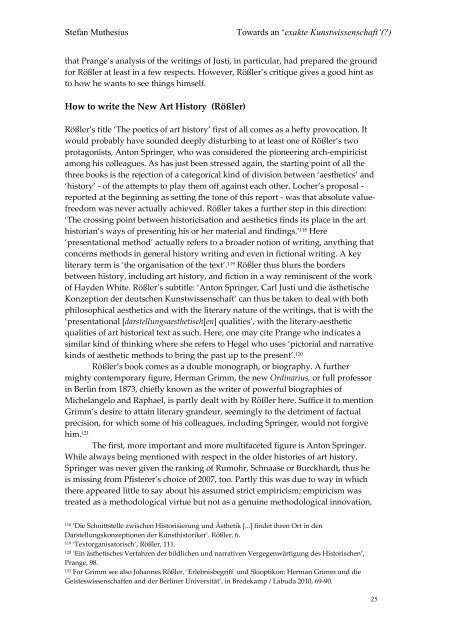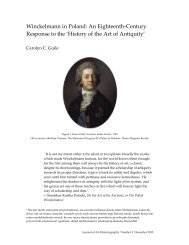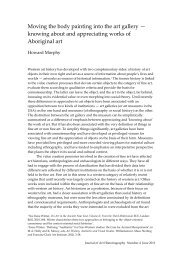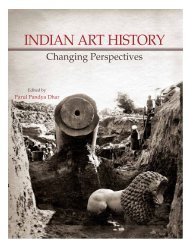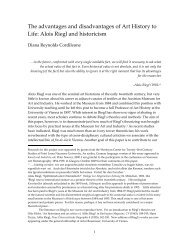9/SM1 - Journal of Art Historiography
9/SM1 - Journal of Art Historiography
9/SM1 - Journal of Art Historiography
You also want an ePaper? Increase the reach of your titles
YUMPU automatically turns print PDFs into web optimized ePapers that Google loves.
Stefan Muthesius<br />
Towards an ‘exakte Kunstwissenschaft‘(?)<br />
that Prange’s analysis <strong>of</strong> the writings <strong>of</strong> Justi, in particular, had prepared the ground<br />
for Rößler at least in a few respects. However, Rößler’s critique gives a good hint as<br />
to how he wants to see things himself.<br />
How to write the New <strong>Art</strong> History (Rößler)<br />
Rößler’s title ‘The poetics <strong>of</strong> art history’ first <strong>of</strong> all comes as a hefty provocation. It<br />
would probably have sounded deeply disturbing to at least one <strong>of</strong> Rößler’s two<br />
protagonists, Anton Springer, who was considered the pioneering arch-empiricist<br />
among his colleagues. As has just been stressed again, the starting point <strong>of</strong> all the<br />
three books is the rejection <strong>of</strong> a categorical kind <strong>of</strong> division between ‘aesthetics‘ and<br />
‘history’ - <strong>of</strong> the attempts to play them <strong>of</strong>f against each other. Locher’s proposal -<br />
reported at the beginning as setting the tone <strong>of</strong> this report - was that absolute valuefreedom<br />
was never actually achieved. Rößler takes a further step in this direction:<br />
‘The crossing point between historicisation and aesthetics finds its place in the art<br />
historian’s ways <strong>of</strong> presenting his or her material and findings.’ 118 Here<br />
‘presentational method’ actually refers to a broader notion <strong>of</strong> writing, anything that<br />
concerns methods in general history writing and even in fictional writing. A key<br />
literary term is ‘the organisation <strong>of</strong> the text’. 119 Rößler thus blurs the borders<br />
between history, including art history, and fiction in a way reminiscent <strong>of</strong> the work<br />
<strong>of</strong> Hayden White. Rößler’s subtitle: ‘Anton Springer, Carl Justi und die ästhetische<br />
Konzeption der deutschen Kunstwissenschaft’ can thus be taken to deal with both<br />
philosophical aesthetics and with the literary nature <strong>of</strong> the writings, that is with the<br />
‘presentational [darstellungsaesthetisch[en] qualities’, with the literary-aesthetic<br />
qualities <strong>of</strong> art historical text as such. Here, one may cite Prange who indicates a<br />
similar kind <strong>of</strong> thinking where she refers to Hegel who uses ‘pictorial and narrative<br />
kinds <strong>of</strong> aesthetic methods to bring the past up to the present’. 120<br />
Rößler’s book comes as a double monograph, or biography. A further<br />
mighty contemporary figure, Herman Grimm, the new Ordinarius, or full pr<strong>of</strong>essor<br />
in Berlin from 1873, chiefly known as the writer <strong>of</strong> powerful biographies <strong>of</strong><br />
Michelangelo and Raphael, is partly dealt with by Rößler here. Suffice it to mention<br />
Grimm’s desire to attain literary grandeur, seemingly to the detriment <strong>of</strong> factual<br />
precision, for which some <strong>of</strong> his colleagues, including Springer, would not forgive<br />
him. 121<br />
The first, more important and more multifaceted figure is Anton Springer.<br />
While always being mentioned with respect in the older histories <strong>of</strong> art history,<br />
Springer was never given the ranking <strong>of</strong> Rumohr, Schnaase or Burckhardt, thus he<br />
is missing from Pfisterer’s choice <strong>of</strong> 2007, too. Partly this was due to way in which<br />
there appeared little to say about his assumed strict empiricism; empiricism was<br />
treated as a methodological virtue but not as a genuine methodological innovation,<br />
118<br />
‘Die Schnittstelle zwischen Historisierung und Ästhetik [...] findet ihren Ort in den<br />
Darstellungskonzeptionen der Kunsthistoriker’. Rößler, 6.<br />
119<br />
‘Textorganisatorisch’, Rößler, 111.<br />
120<br />
‘Ein ästhetisches Verfahren der bildlichen und narrativen Vergegenwärtigung des Historischen’,<br />
Prange, 98.<br />
121<br />
For Grimm see also Johannes Rößler, ‘Erlebnisbegriff und Skioptikon: Herman Grimm und die<br />
Geisteswissenschaften and der Berliner Universität’, in Bredekamp / Labuda 2010, 69-90.<br />
25


